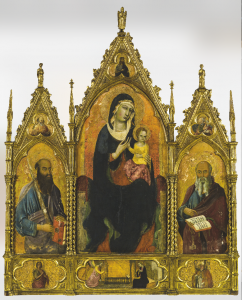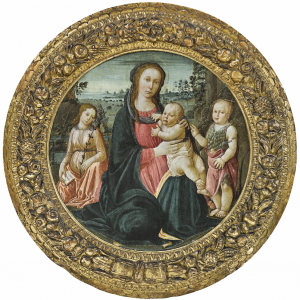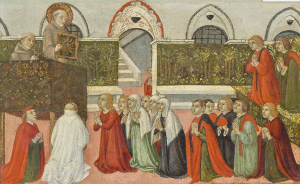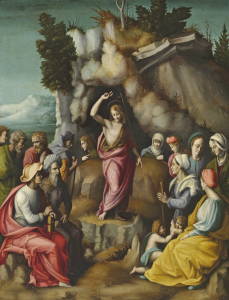15th-century Florence saw a renewed interest in classical sources and a new interest in naturalistic form emerging in art. The zeitgeist of the Renaissance is reflected both in secular commissions and devotional art. The Dorotheum auction of Old Masters includes some outstanding items from the period.
During the Renaissance the funding of large public projects by the civic authorities of Florence gave ample scope to artists. In the first few decades of the 15th century Donatello, Lorenzo Ghiberti and Nanni di Banco created figures for the façades of the Cathedral, the Loggia della Signoria (now Loggia dei Lanzi), Orsanmichele and the Baptistery that combine classical simplicity and monumentality of form with naturalistic pose and modelling. Sculpture, in turn, influenced painters, architects and other artists.
The Renaissance in Florence was a historical period of cultural revival. It was a pivotal era of artistic production which derived creative inspiration from classical models and values that were to spread from Italy throughout Europe and beyond over the course of the 16th century.
“The Battle of Pharsalus” by Apollonio di Giovanni (Florence, ca. 1415/17–1465) is to be offered for sale in the auction of Old Master Paintings on 25 April 2017. It can be seen as an important exponent of 15th-century painting, combining recent developments in Florentine monumental painting with a sense of narrative and emotional expressiveness that animates this highly decorative and beautifully executed panel. Responding to the aspirant classical interests of his patrons, Apollonio introduced many new subjects from antique and modern literature into contemporary Florentine art. The painted decoration on chests often depicted historical events, in particular battles derived from mythology, classical literature and medieval novellas, as well as literary allegories and religious themes.
The present painting on panel originally formed the front part of a lavishly decorated chest, a cassone, which was a popular type of decorative furniture in Renaissance Italy. Chests, in which personal belongings could be stored, were often produced in pairs and adorned with paintings and pastiglia ornaments. As an item that was usually carried in dowry by a bride at the time of her marriage, cassoni acquired an important role in displaying the social status, wealth and sophistication of intermarrying families. They were widespread in Northern and Central Italy, particularly in Tuscany, between the 14th and 16th centuries, and were usually created by specialists who produced them and related types of painting such as birthing trays (deschi da parto) and wall panels (spalliere).
Active between the late 1430s and the 1460s, the painter of the present panel, Apollonio di Giovanni, was arguably the most well-documented and celebrated exponent of this type of working practice in mid-Quattrocento Florence. The panel displays a sumptuous naturalism reminiscent of Gentile da Fabriano’s altarpiece of the “Adoration of the Magi” (Uffizi, Florence), created for the Florentine banker Palla Strozzi in 1423. As in Masaccio’s works, figures are placed in a seemingly realistic pictorial space, but there is also a strong emphasis on elements of decorative ornament and pattern. The use of perspective derived from Filippo Brunelleschi’s new architectural style based on classical models. Leon Batista Alberti had codified these achievements in his theoretical treatise “De pictura” in 1435. By now, Florence had established itself as the foremost centre of Renaissance culture in the 15th century.
The use of linear perspective revolutionized the treatment of space, and Florentine artists made creative use of the new technique from the second third of the 15th century onwards. Apollonio di Giovanni’s panel is particularly reminiscent of the work of fellow Florentine Paolo Uccello who, in his paintings, set figures in environments that seemed to extend the real space of the viewer, as can be seen in the set of three panel paintings depicting the “Rout of San Romano”.
The workshop tradition might have engendered stultified, conservative art, but in Florence that was not the case. The city’s artists maintained a high degree of originality, and clients seem to have valued innovation. Giorgio Vasari noted that the spirit of competition was important in the development of the best Florentine artists.
Devotional and secular
By the mid-15th century, the dominant mode of patronage had changed from corporate to personal, largely through the Medici family’s expression of its power and immense wealth in terms of patronage of the arts. For example, the extent of Cosimo de’ Medici’s commissions at San Lorenzo and San Marco rivalled that of even the richest guilds.
Devotional art also entered the domestic arena. However strong the present day emphasis on artists’ secular presentation of self may be, the vast majority of Renaissance art works served the purpose of Christian devotion. Commissions followed the established typologies of the icon, small-scale devotional image, ex-voto, altarpiece, and cycles featuring episodes from the Old and New Testaments and other sacred narratives.
The tondo “Madonna and Child with the Archangel Gabriel and the Infant Saint John the Baptist” by Jacopo del Sellaio (Florence circa 1441–1493) is an important example of this popular Florentine art form.
The round format is one of the countless inventions of Florentine Quattrocento painting. These painted wooden panels were not conceived as altarpieces for churches, but served the purpose of private devotion in the palaces of Florentine patricians, where they were frequently installed in the bedrooms. The roundel soon spread across Tuscany and beyond its borders, but it originated in Florence. This pictorial type demonstrates, among other things, a demand for religious works outside the world of churches and monasteries. In the present painting we can see two iconographic types united in the figure of the Virgin: that of the nursing Madonna (Madonna del latte) and that of the Madonna of humility (Madonna dell’umiltà).
Jacopo del Sellaio also executed numerous cassoni and spalliere panels featuring themes from the Old Testament and Roman history in collaboration with other masters present in his workshop. His known oeuvre displays Sandro Botticelli’s influence, which occasionally also blends in with stylistic elements derived from other contemporaries. In the present composition, the impact of Jacopo del Sellaio’s teacher Fra Filippo Lippi is strongly evident. The work, which can roughly be assigned to the period between 1470 and 1490, is of a remarkably high quality and an entirely characteristic product of Early Renaissance Florentine painting.
Variety of styles
By the end of the 15th-century, turbulent economic, political and social conditions as well as the preaching of Girolamo Savonarola severely affected private patronage in Florence. The expulsion of the Medici family in 1494 led to the re-establishment of the republic, which initiated projects promoting the new regime.
These centred on the Palazzo della Signoria, now Palazzo Vecchio, and Michelangelo was commissioned in 1501 to complete the colossal statue of David, a traditional symbol of Florentine liberty. However, the classical form of art was to continue to predominate, and artists from the city of Florence would remain at the forefront of artistic production.

With the return of the Medici in 1512, the sculptural and architectural embellishment of San Lorenzo was revived, principally under Michelangelo. At the same time, younger Florentine painters, chiefly Rosso Fiorentino and Jacopo da Pontormo, began to develop particular High Renaissance characteristics, contributing to the eclectic variety of styles now known as Mannerism.
Francesco Ubertini, called il Bachiacca (1494–1557), was of the same generation. His painting “The preaching of Saint John the Baptist” is an important, well-conserved example of the elegant and cerebral Mannerist style predominant in Florence towards the second quarter of the 16th century.
Information: Mark MacDonnell
specialist for Old Master paintings

















